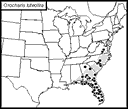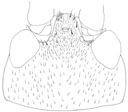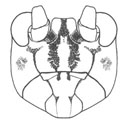|
Song at 25°C:
|
Loud peep emitted at irregular 1.5–3 s intervals. Difficult to localize. Neighbors seem to alternate and are often noticeably different in pitch. Chirps have 4–9 pulses at 72 p/s. Carrier frequencies decrease more than 1 kHz at lower temperatures.
|
|
Identification:
|
Length 15–21 mm. Ocellar diameter less than distance between lateral and median ocellus; no conical projections at lateral ocelli; sometimes one at median ocellus; some bristles longer than 0.1 mm on head behind lateral ocelli. Facial pattern varies but median light area reaches midpoint of epistomal suture. Stridulatory file has 66–82 teeth.
|
|
Similar species:
|
(l) Jumping bush cricket (O. saltator)—no distinguishing morphological features; chirps longer (0.15 s) with more pulses (10-18) and slower pulse rate (55/s). Where O. saltator and O. luteolira occur together, O. saltator is most abundant in dense, lowland woods and has one generation each year with adults in Aug.–Oct. (2) Three-horned bush cricket (O. tricornis)—conical projections over the lateral ocelli.
|
|
Habitat:
|
Broad-leaved trees; occasionally in herbaceous undergrowth, shrubs, and pine trees. Southernmost records are from broad-leaved woody undergrowth of pine and cypress forests.
|
|
Season:
|
Year-round in peninsular Florida with peaks of singing at Gainesville in Nov.-Dec. and May-June. Two generations apparent farther north, with adults peaking in early and late summer (June and Aug.-Sept.).
|
|
Remarks:
|
The geographical distributions of this species and the morphologically as-yet-indistinguishable jumping bush cricket overlap extensively. In the areas of overlap no intermediate calling songs occur, as would be expected if the two species were hybridizing, nor are there greater differences in calling songs, as might be expected if songs were confusingly similar to females. The two species maintain distinctive one-and-two-generation life cycles, but their mating seasons coincide in late summer.
|
|
More information:
|
Subfamily Eneopterinae, genus Orocharis.
|
|
Nomenclature:
|
OSF (Orthoptera Species File Online).
|














